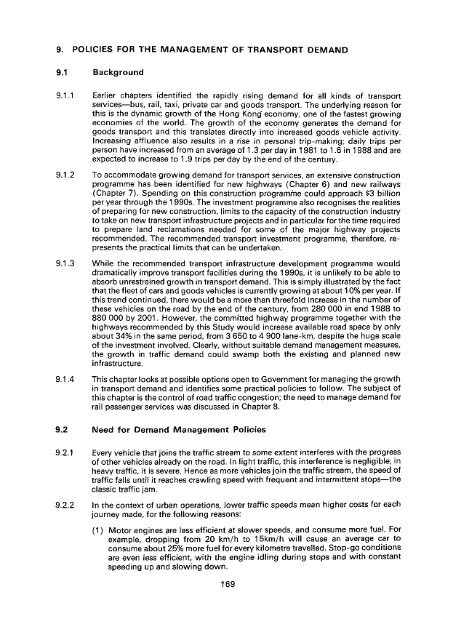Untitled - HKU Libraries - The University of Hong Kong
Untitled - HKU Libraries - The University of Hong Kong
Untitled - HKU Libraries - The University of Hong Kong
- No tags were found...
You also want an ePaper? Increase the reach of your titles
YUMPU automatically turns print PDFs into web optimized ePapers that Google loves.
9. FOR OF9.19.1.1 Earlier chapters identified the rapidly rising demand for ail kinds <strong>of</strong> transportservices—bus, rail, taxi, private car and goods transport. <strong>The</strong> underlying reason forthis is the dynamic growth <strong>of</strong> the <strong>Hong</strong> <strong>Kong</strong> economy, one <strong>of</strong> the fastest growingeconomies <strong>of</strong> the world. <strong>The</strong> growth <strong>of</strong> the economy generates the demand forgoods transport and this translates directly into increased goods vehicle activity,increasing affluence also results in a rise in personal trip-making; daily trips perperson have increased from an average <strong>of</strong> 1.3 per day in 1981 to 1.6 in 1988 and areexpected to increase to 1.9 trips per day by the end <strong>of</strong> the century.9.1.2 To accommodate growing demand for transport services, an extensive constructionprogramme has been identified for new highways (Chapter 6) and new railways(Chapter 7). Spending on this construction programme could approach $3 billionper year through the 1990s. <strong>The</strong> investment programme also recognises the realities<strong>of</strong> preparing for new construction, limits to the capacity <strong>of</strong> the construction industryto take on new transport infrastructure projects and in particular for the time requiredto prepare land reclamations needed for some <strong>of</strong> the major highway projectsrecommended. <strong>The</strong> recommended transport investment programme, therefore, representsthe practical limits that can be undertaken.9.1.3 While the recommended transport infrastructure development programme woulddramatically improve transport facilities during the 1990s, it is unlikely to be able toabsorb unrestrained growth in transport demand. This is simply illustrated by the factthat the fleet <strong>of</strong> cars and goods vehicles is currently growing at about 10% per year. Ifthis trend continued, there would be a more than threefold increase in the number <strong>of</strong>these vehicles on the road by the end <strong>of</strong> the century, from 280 000 in end 1988 to880 000 by 2001. However, the committed highway programme together with thehighways recommended by this Study would increase available road space by onlyabout 34% in the same period, from 3 650 to 4 900 lane-km, despite the huge scale<strong>of</strong> the investment involved. Clearly, without suitable demand management measures,the growth in traffic demand could swamp both the existing and planned newinfrastructure.9.1.4 This chapter looks at possible options open to Government for managing the growthin transport demand and identifies some practical policies to follow. <strong>The</strong> subject <strong>of</strong>this chapter is the control <strong>of</strong> road traffic congestion; the need to manage demand forrail passenger services was discussed in Chapter 8.9.2 Need for Demand Management Policies9.2.1 Every vehicle that joins the traffic stream to some extent interferes with the progress<strong>of</strong> other vehicles already on the road. In light traffic, this interference is negligible; inheavy traffic, it is severe. Hence as more vehicles join the traffic stream, the speed <strong>of</strong>traffic falls until it reaches crawling speed with frequent and intermittent stops—theclassic traffic jam.9.2.2 In the context <strong>of</strong> urban operations, lower traffic speeds mean higher costs for eachjourney made, for the following reasons:(1) Motor engines are less efficient at slower speeds, and consume more fuel. Forexample, dropping from 20 km/h to 15knn/h will cause an average car toconsume about 25% more fuel for every kilometre travelled. Stop-go conditionsare even less efficient, with the engine idling during stops and with constantspeeding up and slowing down.169
















